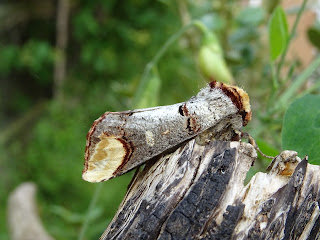Sunday, 31st May 2020
Episode VIII was only relentless progress but this episode documents rapid progress as SIX species of butterfly were ticked off the list in TWO days. Not only that but two worrisome species, High brown fritillary and Small white were finally encountered.
Following our failure to find High brown fritillary at Whitbarrow Scar our hero spent many an anxious hour searching the internet for any clue as to where they may be found . Eventually he came up with Craig Ddu which is south east part of Old Castle Down, Ewenni.
Now I am sure you will all know where that is, but just in case you have a slight doubt, the site is located just south of Bridgend.
On a beautiful summer's day our hero with his two companions made our way down the M6, M5 and M4 to Bridgend and then onto Ewenni, Here the fun began as we tried to find the road to the site.
After negotiating some very narrow sections the road eventually led us to start of the path to Craig Ddu.
We parked opposite a well vegetated area and whilst scanning this we noticed that there were large fritillaries flying about.
Could they be ...?
When I said well-vegetated I mean the vegetation was almost as tall as we were and very dense. This made chasing a flighty orange butterfly quite tricky, and getting close enough to one when it briefly settled almost impossible.
But we persevered and managed to photograph one.
... No it wasn't!
It was Dark green fritillary.
Up the hill we went, eventually reaching a bracken covered plateau. Ideal habitat, I was told, for our target species of the day. All we needed now was for a High brown fritillary to know that it was ideal habitat and honour us with its presence long enough for us to be able to make a positive identification.
An orange butterfly appeared.
And disappeared in the blink of an eye.
Then another, and another.
None hung around long enough to be identified.
One settled ...
Dark green fritillary.
Another settled … another Dark green.
And so it continued until this butterfly was photographed.
Number 46: High brown fritillary
 |
| Photograph: Bob Kemp |
You can see the silver dots surrounded by a brown ring on the underside of the hindwing which indicates this species. No mistake this time.
Target species found we continued to explore the site accompanied by the piercing "little bit of bread and no cheese" call of a yellowhammer.
Whilst being watched by an alert Stonechat.
And we had the opportunity to see one of our star photographers in his natural environment.
Flushed by success we returned home happy and our hero was wearing a couple less furrows on his brow.
But still no small white. Surely this butterfly was not going to scupper the quest. A furrow was added
No rest. The following day a return trip to Whitecross Green wood was undertaken. Unfortunately I had a date with the gasman and could not go, so am unable to flesh out the details of this trip in which five butterflies were ticked off the list taking our hero into the fifties and onto the home stretch.
Number 47: White admiral
 |
| Photographer: David Williams |
Number 48: Purple emperor
 |
| Photographer: David Williams |
Number 49: Silver-washed fritillary
 |
| Photographer: Bob Kemp |
 |
| Photographer: David Williams |
 |
| Photographer: David Williams |
Number 50: Gatekeeper
And at long last ...
Number 51: Small white
 |
| Photographer: David Williams |
Phew!
51 down 7 to go.
More next time when it will include a couple of trips on which I did accompany our hero.
To finish, here are some of the photographs I have taken or been sent over the last seven days or so of things that have been spotted when exercising or in our gardens.
A pair of Azure damselflies concentrating on generating the next generation.
A birch shieldbug
 |
| Photograph: John Martin |
A Common carder bee on the flower of a Yellow iris.
A Broad-bodied chaser.
 |
| Photograph: David Williams |
 |
| Photograph: David Williams |
A recent arrival in the county, the mirid bug, Closterotomus trivialis.
 |
| Photograph: Dan Wrench |
A Common green grasshopper.
 |
| Photograph: David Williams |
A Common spotted orchid.
Amorous Dingy skippers.
 |
| Photograph: David Williams |
An Elephant hawk-moth.
 |
| Photograph: Bob Kemp |
A purple Field grasshopper nymph
 |
| Photograph: David Williams |
A Forest bug nymph
A Hairy shieldbug.
A Poplar hawkmoth.
 |
| Photograph: Bob Kemp |
And finally a Rhingia campestris feeding at Ragged robin.
Keep well.






































































